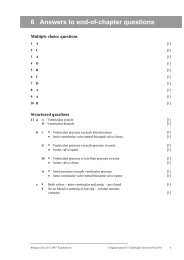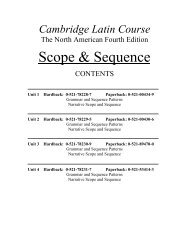1 Working together
1 Working together
1 Working together
You also want an ePaper? Increase the reach of your titles
YUMPU automatically turns print PDFs into web optimized ePapers that Google loves.
1<br />
<strong>Working</strong> <strong>together</strong><br />
1<br />
We’re going to:<br />
talk and write about what people are doing<br />
follow and give instructions<br />
play games and do projects <strong>together</strong><br />
write about what we think and what we like<br />
read and talk about a story.<br />
1 Talk about it These children are learning the Dragon Dance for Chinese<br />
New Year. Talk about the picture. What is each person doing?<br />
Draft sample<br />
2 Listen<br />
Choose a question. Listen for the answer, then share it with your class.<br />
• How do the children make the dragon move?<br />
• What is Steve doing?<br />
• Is learning the Dragon Dance easy or difficult?<br />
6 Unit 1 Lesson 1Vocabulary: movement Use of English: easy or difficult Let’s do it! learning a dance Listen/Read: The Dragon Dance Talk: activities Write: a poem
3 Read<br />
Read and listen to the text. Write a question to ask your class. Use question<br />
words like Where …? What …? How …? Who …?<br />
The Dragon Dance<br />
Chinese New Year is celebrated in China and in many<br />
other countries too. The Dragon Dance is part of the<br />
celebration. Some New Year dragons are very long.<br />
A long dragon brings good luck! The dancers hold up<br />
the dragon with poles. They make the dragon move<br />
up and down, left and right. As the drum beats slowly<br />
or quickly, the dragon twists, turns and dances through the air.<br />
4 Word study<br />
Stand up. Pretend that you are holding up the<br />
dragon on a pole. Act out the words in the box.<br />
5 Write<br />
Use the words above to write a poem about the Dragon Dance.<br />
6 Let’s do it!<br />
Learn a new dance. Stand in a line,<br />
one behind the other. Move <strong>together</strong>!<br />
1 Tap your left foot to the left.<br />
2 Tap your right foot to the right.<br />
3 Jump forwards twice.<br />
4 Do it again!<br />
Say these words as you do the dance:<br />
Left foot. Right foot. Jump. Jump.<br />
7 Use of English<br />
Is it easy or difficult? What do you think?<br />
• learning a dance • playing football<br />
• writing a poem • playing the guitar<br />
• speaking English • riding a bike<br />
up<br />
down<br />
left<br />
right<br />
slowly<br />
quickly<br />
Draft sample<br />
twist<br />
turn<br />
dance<br />
7
2<br />
Let’s play!<br />
1 Talk about it What do you and your friends like doing <strong>together</strong>?<br />
2 Read<br />
Read the instructions. Then play each game.<br />
Two can tie a bow<br />
Can you and your partner work<br />
<strong>together</strong> to tie a bow? This is not<br />
easy. Each person can only use<br />
one hand!<br />
Up and down<br />
Sit on the floor, back-to-back<br />
with your partner. Link your<br />
elbows <strong>together</strong>. Try to stand up!<br />
Then sit down again.<br />
Don’t step on the floor<br />
Draft sample<br />
You and your partner need three<br />
pieces of paper.<br />
You must cross from one side of<br />
the room to the other.<br />
You must only step on the paper.<br />
You mustn’t step on the floor.<br />
Can you do it?<br />
8<br />
Unit 1 Lesson 2 Listen: recognising expressions Let’s find out! using a chart Read: following instructions Values: giving encouragement
2<br />
Eleven fingers<br />
You need three people. Stand in a circle. Together,<br />
say ‘1, 2, 3 … Go!’ When you say ‘Go!’, hold out<br />
some fingers on one hand: 1, 2, 3, 4 or 5 fingers.<br />
Add up all the fingers in the circle. To win the game,<br />
you must have 11 fingers. How many tries does<br />
it take?<br />
3 Values<br />
Some of these games are difficult. You have to practise and you mustn’t<br />
give up. Try using some of these expressions as you play the games.<br />
Don’t give up!<br />
4 Listen<br />
Which game are the children playing? Clap when you<br />
hear one of the expressions from Activity 3.<br />
5 Let’s find out!<br />
1 Were the games easy or difficult? Which was your favourite?<br />
2 Look at the chart. Which game do most children in that class like best?<br />
3 Now make a chart for your class. Which game does your class like best?<br />
Two can tie a bow<br />
Up and down<br />
Don’t step on the floor<br />
Eleven fingers<br />
Let’s try again.<br />
That’s good.<br />
Our favourite games<br />
We’ve done it!<br />
Draft sample<br />
Key:<br />
= 1 child<br />
9
3<br />
Team activities<br />
1 Read Read these instructions and look at the picture.<br />
Which colour team is doing each activity: red, yellow, green or purple?<br />
Tie two ropes around the tree.<br />
2 Use of English<br />
Climb to the top of the wall.<br />
Match the question with the answer.<br />
1 What are the children in green<br />
tops doing?<br />
2 What is boy number 17 doing?<br />
3 What are the children in yellow<br />
tops doing?<br />
4 What is girl number 28 doing?<br />
3 Talk<br />
Ask your partner two more questions about the picture.<br />
What is/are ... doing?<br />
Pass a glass of water through the ring.<br />
Carry the boxes to the table.<br />
a They are tying a rope around<br />
the tree.<br />
b They are carrying boxes to<br />
the table.<br />
c She is standing on a ladder.<br />
d He is climbing the wall.<br />
Draft sample<br />
4 Word study<br />
Think of lots of different answers to these questions!<br />
• What can you push? • What can you climb? • What can you carry?<br />
10<br />
Unit 1 Lesson 3 Vocabulary: action verbs Use of English: team activities Let’s do it! action numbers Read: Rope Rhyme Talk: team activities
4<br />
5 Read<br />
Read and listen to the poem. Then answer the questions.<br />
Find the word in the poem that rhymes with:<br />
in ground to ten about<br />
Find a word in the poem that means the same as:<br />
Rope Rhyme by Eloise Greenfield<br />
Get set, ready now, jump right in<br />
Bounce and kick and giggle and spin<br />
Listen to the rope when it hits the ground<br />
Listen to that clappedy-slappedy sound<br />
Jump right up when it tells you to<br />
Come back down, whatever you do<br />
Count to a hundred, count by ten<br />
Start to count all over again<br />
That’s what jumping is all about<br />
Get set, ready now,<br />
jump<br />
right<br />
out!<br />
laugh turn round<br />
6 Let’s do it!<br />
Pretend you are skipping! Count up to 100, one number with each jump.<br />
When you say a number that ends in 5, kick your leg: 15, 25, 35 ...<br />
When you say a number that ends in 0, spin around: 10, 20, 30 ...<br />
7 Word study<br />
Action verbs are things you can do – like jump, sit and giggle.<br />
Make a list of action verbs on pages 10 and 11.<br />
How many can you find? Think of more words to add to your list.<br />
begin<br />
Draft sample<br />
11
4<br />
Performing a play<br />
1 Read These children are going to act in a play.<br />
They are making signs for the animal characters in the play.<br />
3<br />
a Some children are drawing mammals. A mammal is an animal<br />
that feeds its babies itself. Most mammals have four legs and fur.<br />
b Some children are drawing birds. Birds are animals that lay eggs.<br />
They have two legs, two wings and feathers.<br />
c One child is drawing a bat.<br />
Do you think a bat is a mammal or a bird?<br />
2 Listen<br />
Listen to the conversation. Fill in the missing words.<br />
Ana: What can I be?<br />
Vijay: How about a __?<br />
Ben: __ ____ a tiger?<br />
Ana: That’s a ___ ____. I’ll be a tiger!<br />
Draft sample<br />
Why does Vijay want to be a kangaroo? Listen again and talk about the answer.<br />
3 Talk<br />
Imagine that you are going to act in a play!<br />
Do you want to be a mammal or a bird?<br />
Which mammal or bird? Why? Ask three friends.<br />
What do you<br />
want to be?<br />
How about<br />
an owl?<br />
12<br />
Unit 1 Lesson 4 Use of English: adding -ing Let’s do it! animal game Listen/Talk: what you want to be / what you are doing<br />
Over to you: what you are good / not good at Read: what people are doing
4<br />
4 Listen<br />
Tony is drawing a picture of a bat.<br />
Listen to the conversation, then<br />
answer the questions.<br />
1 What is Tony good at doing?<br />
2 What is Tony not good at doing?<br />
3 What is the missing word in<br />
Tony’s picture?<br />
5 Over to you<br />
What are you good at doing? What are you not good at doing?<br />
Tell your partner.<br />
I’m good at __________, but I’m not good at ________.<br />
Then write a sentence about your partner.<br />
Tell the class about your partner.<br />
Language detective<br />
Adding –ing<br />
What happens when you add –ing to a short<br />
vowel word that ends in a consonant?<br />
run – running hop – hopping swim – ?<br />
What happens when you add –ing to a<br />
word that ends in a silent e?<br />
dance – dancing write – writing make – ?<br />
Jenny is good at<br />
dancing, but she’s not<br />
good at skipping.<br />
Draft sample<br />
6 Let’s do it!<br />
Play this spelling game. Write the name of an animal. Don’t show<br />
your friends. Spell the name – your friends must write the word.<br />
They have to make a sound like that animal or act like the animal.<br />
13
5<br />
Whose team are you on?<br />
1 Talk about it Look at the pictures.<br />
Who are the characters? What do you<br />
think happens in this play?<br />
5<br />
2 Listen and read<br />
Listen and read along.<br />
Whose team are you on?<br />
Narrator: The animals are getting ready for a football match. Fox,<br />
Kangaroo, and Bear are on the Mammal team. Goose, Owl,<br />
and Parrot are on the Bird team. Bat wants to play too.<br />
Bat (eagerly): Can I play?<br />
Parrot: Which team are you on?<br />
Bat (thinking to himself): Hmm. I want to be on the winning team. The Birds<br />
are small. The Mammals are big. I think the Mammals will<br />
win.<br />
Bat (aloud): I want to be on the Mammal team!<br />
Bear (to Fox and Kangaroo): Are bats mammals?<br />
Fox:<br />
I don’t think so. Bats have wings. Mammals don’t have wings.<br />
I think Bat is a bird.<br />
Bat:<br />
No, I’m not. I’m a mammal! Look at my fur! Look at my<br />
teeth! Birds don’t have fur or teeth.<br />
Kangaroo (to Fox and Bear): That’s true. I think Bat can play on our team.<br />
Fox and Bear: OK. Let’s play!<br />
Narrator: The animals begin to play. Bear passes the ball to Kangaroo.<br />
Kangaroo kicks the ball into the goal. The score is<br />
Mammals – 1; Birds – 0.<br />
Bat (happy and excited): Hooray for our team!<br />
Narrator: Next, Owl gets the ball. Owl<br />
passes the ball to Parrot.<br />
Parrot scores a goal.<br />
Mammals – 1; Birds – 1! It’s a draw!<br />
Draft sample<br />
14 Unit 1 Lesson 5 Literature: Whose team are you on?
Narrator: Bear has the ball next, but Parrot takes it. The birds score<br />
another goal. Birds – 2; Mammals – 1.<br />
The birds score the next goal, too. Now it’s Birds – 3; Mammals – 1!<br />
Bear:<br />
Let’s stop! We need a rest.<br />
Bat (feeling grumpy, thinking to himself): The Mammal team is losing. I don’t<br />
want to be on the losing team. I think I’ll join the Bird team.<br />
Bat (walking over to talk to Parrot): I’m joining the Bird team.<br />
Parrot: You can’t do that, Bat! You’re part of the Mammal team.<br />
Bat:<br />
Not any more. I want to be on the Bird team! Look – I have two<br />
wings and two legs – just like you and Owl and Goose!<br />
Goose: Play on!<br />
Narrator: The game begins again. Kangaroo has the ball. She passes the ball<br />
to Bear, but Bat takes the ball and passes it to Parrot. Parrot scores a<br />
goal. It’s Birds – 4; Mammals – 1.<br />
Bat (happy and excited): Hooray for our team! The Birds are winning the game!<br />
Fox (confused): Stop the game! Whose team are you on, Bat?’<br />
Bat:<br />
I’m on the Birds team now. And we are winning!<br />
Owl (sternly): You can’t switch teams in the middle of a match, Bat.<br />
Goose: It’s not fair!<br />
Draft sample<br />
15
Bear (angrily): You are not a good team player, Bat. You can’t be part of this<br />
game!<br />
Fox (sternly): I agree. If you want to play with us, you need to follow the rules.<br />
All the animals (speaking <strong>together</strong>): Go away, Bat! We don’t want to play with you.<br />
Bat (upset): I’m sorry.<br />
Kangaroo: Go away and think about it. When you are ready to follow the<br />
rules, you can come back.<br />
Bat (sadly):<br />
Narrator:<br />
Owl:<br />
OK. Goodbye.<br />
And the Mammals and the Birds begin<br />
playing again without Bat.<br />
Play on!<br />
The rules<br />
• Practise every day<br />
• Do your best.<br />
• Help your team.<br />
• Be a good loser.<br />
Say, ‘Well done!’ to<br />
the other team.<br />
• Be a good winner.<br />
Say ‘Thank you!’ to<br />
the other team.<br />
Draft sample<br />
16<br />
Unit 1 Lesson 5 Literature: Whose team are you on? Vocabulary: word meaning Let’s do it! acting out a play Talk: a play<br />
Values: rules Write: a letter
3 Talk<br />
• Why does Bat want to play on the Mammal team?<br />
• Why does Bat switch to the Bird team?<br />
4 Values<br />
Look at the list of rules. Which two do you think are the most important?<br />
5 Let’s do it!<br />
Choose a character and make a sign to wear. Act out the play.<br />
6 Word study What does it mean?<br />
Find the words in blue. What does each word mean?<br />
If you can’t guess, ask your teacher.<br />
Find the words in green. Match them with the meanings below.<br />
a kicks the ball into the net b the number of points for each team<br />
7 Words with more than one meaning:<br />
Complete the sentences with the missing words.<br />
1 She hits the ball with a<br />
____.<br />
2 A _____ can fly.<br />
2<br />
1 3<br />
3 B is the first _____ in<br />
bat.<br />
4 This _____ is for you.<br />
7<br />
AB<br />
Write<br />
Bat wants to play football again. He writes<br />
a letter to the Mammals and the Birds.<br />
What does Bat say in the letter?<br />
4 6<br />
What does<br />
winning mean?<br />
5 Come and _______<br />
football with us!<br />
6 We are acting in<br />
a _______ .<br />
5<br />
Draft sample<br />
Dear Mammals<br />
and Birds<br />
17
6<br />
Choose a project<br />
1<br />
Make a ‘Follow the instructions’ game<br />
1 Work with a group. Write instructions on cards. Make 20 cards.<br />
2<br />
2 Play the game with your class in two teams.<br />
3 The teams take turns to take an instruction card. If the team<br />
can follow the instructions, they score one point.<br />
Make a ‘Find the animal’ game<br />
1 Draw a picture of an animal doing something funny. It can be a real<br />
animal or a make-believe animal.<br />
2 On another piece of paper, write a description of your animal.<br />
Answer these questions:<br />
• What does your animal look like? What colour is it?<br />
• How many legs has it got? Has it got wings? Has it got fur?<br />
• What is your animal doing?<br />
Draft sample<br />
3 Put all the animal<br />
pictures on the wall.<br />
4 Read an animal<br />
description to the<br />
class. Can the class<br />
find the matching<br />
picture?<br />
My animal has got purple fur and six legs.<br />
It is playing the drums.<br />
18<br />
Unit 1 Lesson 6 Choose a project: ‘follow instructions’ game; ‘find the animal’ game’ Reflect on your learning
Reflect on your learning<br />
What can we do <strong>together</strong>?<br />
1 Choose a picture in this unit. Tell your partner what<br />
any people or animals are doing in the picture.<br />
2 Think of some things you can do with a ball. Write<br />
two instructions. Read them to your partner. Can<br />
your partner act out the instructions?<br />
3 Look at your list of action verbs. Write a sentence<br />
about something you like doing and something<br />
you don’t like doing. Read your sentences to your<br />
partner. Do you like or dislike the same things?<br />
4 What do you think about the activities in this unit?<br />
Write your answers.<br />
• Which activity did you like best?<br />
• Which activities were easy? difficult?<br />
interesting? fun? boring?<br />
5 Think of an interesting thing you learned in this<br />
unit. Write one or two sentences about it in your<br />
notebook.<br />
L<br />
Draft sample<br />
k what I can do!<br />
1 I can talk and write about what people are doing.<br />
2 I can follow and give instructions.<br />
3 I can play games and do projects with my classmates.<br />
4 I can talk and write about what I think and what I like.<br />
5 I can read and talk about a story.<br />
19








